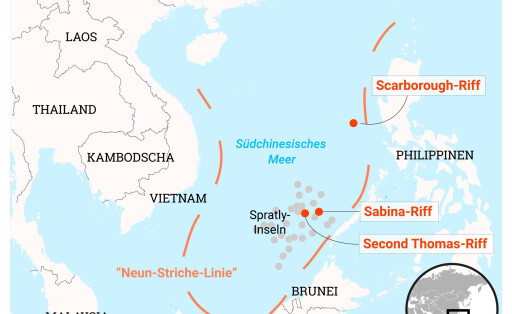The South China Sea is a strategically and economically important body of water that is at the center of one of the world's most complex and contentious territorial disputes. Various littoral states, including China, Taiwan, Vietnam, Malaysia and the Philippines, lay claim to parts of this sea, leading to tensions and international disputes. Geographical location and importance of the South China Sea The South China Sea is a geopolitical hotspot that has a significant impact on regional security and global trade routes. At Table.Briefings, we shed light on the complex web of territorial claims, security interests and environmental challenges that shape the South China Sea. Where is the South China Sea located? The South China Sea is located between China, Taiwan, the Philippines, Vietnam, Malaysia and Brunei. It covers an area of around 3.5 million square kilometers and is a central hub for global trade. Over a third of the world's maritime traffic passes through this sea, which underlines its immense economic importance. In addition, it is believed that there are significant gas and oil reserves in the South China Sea, which further increases the interest of the littoral states. Territorial claims and islands: There are numerous islands, reefs and atolls in the South China Sea that are claimed by several countries. The most important island groups include the Spratly Islands and the Paracel Islands. These islands are not only of interest because of their strategic location, but also because of the potential mineral resources and fishing grounds. Which island in the South China Sea do China, Taiwan, Vietnam, Malaysia and the Philippines claim for themselves? The conflict in the South China Sea What is the conflict in the South China Sea? The conflict in the South China Sea mainly revolves around territorial claims and control over the sea's rich resources. In recent years, China has increased its military presence in the region and built artificial islands that serve as military bases. This has led to tensions with other littoral states and international actors. An overview of the players in the South China Sea conflict: International reactions and the role of the US: The United States has intervened in the conflict in the South China Sea to ensure freedom of navigation and counter China's influence in the region. Regular patrols by the US Navy and joint military exercises with allies are intended to send the message that international waterways must remain open and free. Importance and economic impact: The South China Sea is important not only because of its mineral resource potential, but also because of its role in global trade. About a third of the world's maritime trade passes through this region, making it one of the busiest shipping routes in the world. Security and stability in this area are therefore of global interest. Current developments and controversies: The situation in the region remains tense. Regular military patrols, maritime clashes and diplomatic disputes characterize the news on the South China Sea. China's recent military maneuvers and the increased presence of the US navy have further exacerbated tensions. Conclusion and outlook The conflict in the South China Sea is a complex geopolitical problem that has profound implications for regional and global security. The various territorial claims and military activities of the countries involved have created an atmosphere of uncertainty. The international community is watching the developments with concern, as the stability of this important waterway is crucial for global trade and political balance. The Table.Briefings editorial team reports on what is happening in the region and has all the news, analysis and background on the South China Sea. With breaking news, in-depth analysis and expert opinion, we provide you with the latest information on the dynamics and implications surrounding the South China Sea.

Philippines: Fishermen injured during Chinese coast guard operation
According to the Philippines, three fishermen were injured during an operation by the Chinese Coast Guard in the South China Sea. China said it had carried out “control measures”.
By Leonardo Pape







